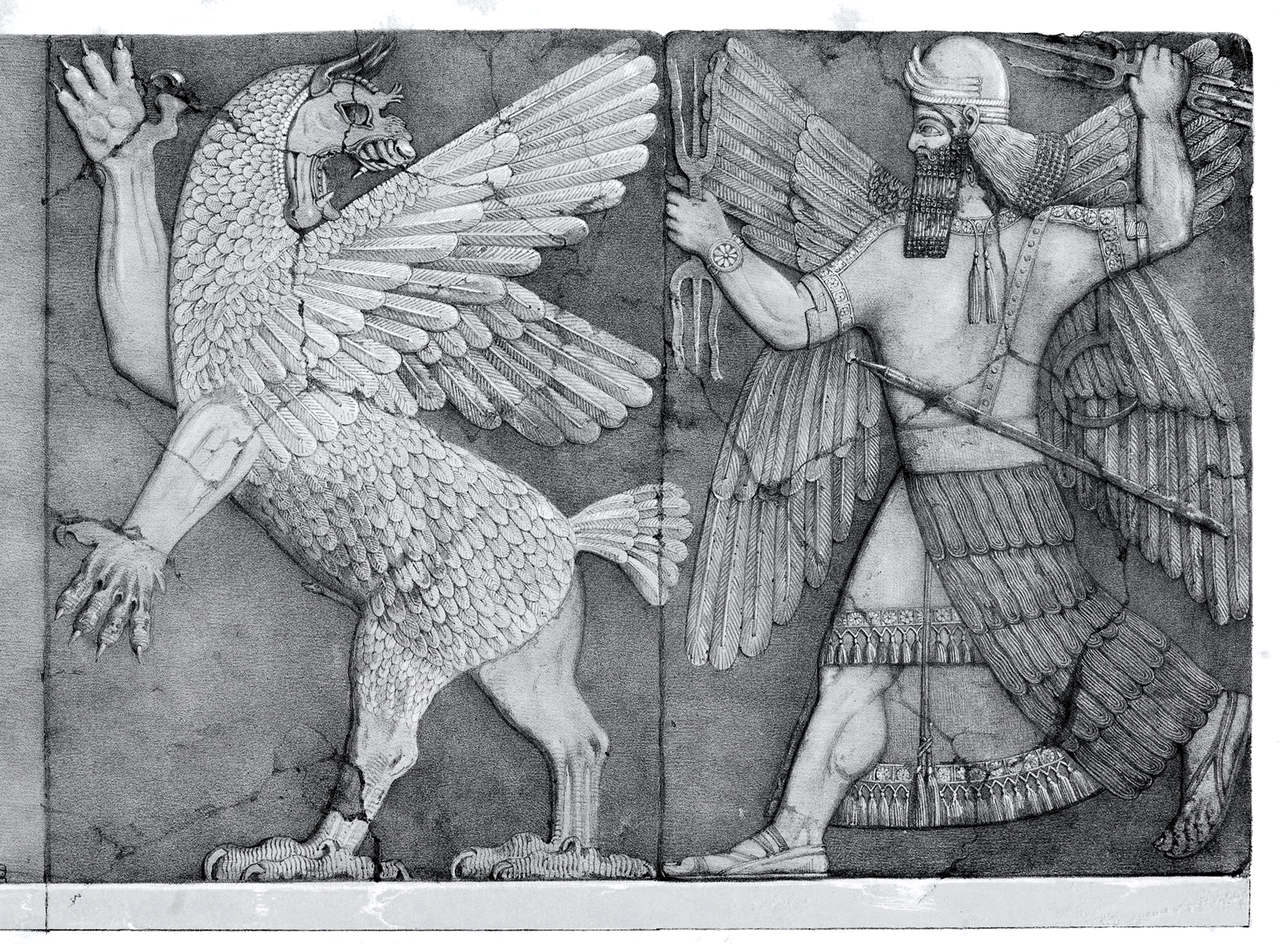11
Earth Awareness / Castration of a Sky God, and the swallowing of a rock in place of a God-child
« Last post by Yeshu on January 07, 2024, 07:23:56 AM »The worship of Kumarbi is attested from sites located in all areas inhabited by the Hurrians, from Anatolia to the Zagros Mountains, though it has been argued that his importance in the sphere of cult was comparatively minor. The oldest possible reference to him occurs in a royal inscription from Urkesh from either the Akkadian or Ur III period, though the correct reading of the name of the deity meant is a matter of scholarly debate. He is also already referenced in texts from Mari from the early second millennium BCE. Further attestations are available from Ugarit, Alalakh, and from the eastern kingdom of Arrapha, where he was worshiped in Azuḫinnu. Furthermore, he was incorporated into the Hittite pantheon, and as one of its members appears in texts from Hattusa, presumed to reflect the traditions of Kizzuwatna. A depiction of him has been identified among the gods from the Yazılıkaya sanctuary. In the first millennium BCE he continued to be worshiped in Taite, and as one of its deities he is attested in the Assyrian Tākultu rituals. He is also attested in Luwian inscriptions from sites such as Carchemish and Tell Ahmar.
Multiple myths focused on Kumarbi are known. Many of them belong to the so-called Kumarbi Cycle, which describes the struggle for kingship among the gods between him and Teshub. The texts usually agreed to belong to it include the Song of Kumarbi (likely originally known as Song of Emergence), the Song of LAMMA, the Song of Silver, the Song of Ḫedammu and the Song of Ullikummi. Kumarbi is portrayed in them as a scheming deity who raises various challengers to depose or destroy Teshub. His plans are typically successful in the short term, but ultimately the adversaries he creates are defeated by the protagonists. Further texts argued to also be a part of the cycle include the Song of the Sea, the Song of Oil, and other fragmentary narratives. Kumarbi also appears in an adaptation of Atrahsasis, where he plays the role which originally belonged to Enlil. Myths focused on him are often compared to other narratives known from the tradition of other neighboring cultures, such as Mesopotamian Theogony of Dunnu or Ugaritic Baal Cycle. It is also commonly assumed that they were an influence on Theogony, especially on the succession of divine rulers and on the character of Kronos. Further works argued to show similar influences include the Phoenician History of Philo of Byblos and various Orphic theogonies, such as that known from the Derveni papyrus.
In standard syllabic cuneiform, the theonym Kumarbi was written as dKu-mar-bi.[4] A byform, Kumurwe, is attested in sources from Nuzi.[1] In Ugaritic texts written in the local alphabetic cuneiform script it was rendered as kmrb (𐎋𐎎𐎗𐎁)[5] or kmrw (𐎋𐎎𐎗𐎆),[6] vocalized respectively as Kumarbi and Kumarwi.[2] A late variant, Kumarma, appears in hieroglyphic Luwian inscriptions, where it is rendered with the signs (DEUS)BONUS, “the good god”.[3] The correct reading has been determined based on a syllabic spelling identified in an inscription from Tell Ahmar, (DEUS.BONUS)ku-mara/i+ra/i-ma-sa5.[7]
Kumarbi’s name has Hurrian origin and can be translated as “he of Kumar”.[8] While no such a toponym is attested in any Hurrian sources,[5] Gernot Wilhelm [de] notes it shows similarities to Hurrian names from the third millennium BCE and on this basis proposes that it might refer to a settlement which existed in the early period of Hurrian history, poorly documented in textual sources.[9] He suggests that its name in turn goes back to the Hurrian root kum,[1] “to pile up”.[10] Examples of other analogously structured Hurrian theonyms include Nabarbi (“she of Nawar”)[11] and possibly Ḫiriḫibi (“he of [the mountain] Ḫiriḫi”).[12] While it has been argued that Aštabi is a further example, his name was originally spelled as Aštabil in Ebla and as such cannot be considered another structurally Kumarbi-like theonym.[13]

Mitanni (/mɪˈtæni/; Hittite: 𒆳𒌷𒈪𒋫𒀭𒉌, romanized: KUR URUMi-ta-an-ni; Mittani or Hittite: 𒈪𒀉𒋫𒉌, romanized: Mi-it-ta-ni), c. 1550–1260 BC, earlier called Ḫabigalbat in old Babylonian texts, c. 1600 BC;[1] Hanigalbat or Hani-Rabbat (Hanikalbat, Khanigalbat, Akkadian: 𒄩𒉌𒃲𒁁, romanized: Ḫa-ni-gal-bat, Ḫa-ni-rab-bat) in Assyrian records, or Naharin in Egyptian texts, was a Hurrian-speaking state with Indo-Aryan linguistic influences in northern Syria and southeast Anatolia (modern-day Turkey). Since no histories, royal annals or chronicles have yet been found in its excavated sites, knowledge about Mitanni is sparse compared to the other powers in the area, and dependent on what its neighbours commented in their texts.
The Hurrians were in the region as of the late 3rd millennium BC.[2] A king of Urkesh with a Hurrian name, Tupkish, was found on a clay sealing dated c. 2300 BC at Tell Mozan.[3][4] The first recorded inscription of their language was of Tish-atal (c. 21st century BC), king of Urkesh.[5] Later on, Hurrians made up the main population of Mitanni, that was firstly known as Ḫabigalbat, at Babylonia, in two texts of the late Old Babylonian period,[1][6] during the reign of Ammi-Saduqa, (c. 1638–1618 BC), in low middle chronology.
The Egyptian official astronomer and clockmaker Amenemhet (Amen-hemet) apparently ordered to write on his tomb that he returned from the "foreign country called Mtn (Mi-ti-ni),"[7][8] but Alexandra von Lieven (2016) and Eva von Dassow (2022) consider that the expedition to Mitanni could have taken place in pharaoh Ahmose I's reign (c. 1550–1525 BC), actually by Amenemhet's father.[9][10] During the reign of pharaoh Thutmose I (1506–1493 BC), the names Mitanni and Naharin are among the reminiscences of several of the pharaoh's officers. One of them, Ahmose si-Abina, wrote: "...His Majesty arrived at Naharin..." Another one, Ahmose pa-Nekhbit, recorded: "...when I captured for him in the land of Naharin..."[11]
After the Battle of Megiddo, an officer of pharaoh Thutmose III (1479–1425 BC), in the pharaoh's 22 regnal year, reported: "That [wretched] enemy of Kadesh has come and has entered into Megiddo. He is [there] at this moment. He has gathered to him the princes of [every] foreign country [which had been] loyal to Egypt, as well as (those) as far as Naharin and M[itanni], them of Hurru, them of Kode, their horses, their armies."[12] In several later military campaigns the Annals of Thutmose III mention Naharin, in particular those of his regnal years 33, 35, and 42.[13] After that time, records become more available from local sources until the empire's end in the mid-13th century BC.[14]
Multiple myths focused on Kumarbi are known. Many of them belong to the so-called Kumarbi Cycle, which describes the struggle for kingship among the gods between him and Teshub. The texts usually agreed to belong to it include the Song of Kumarbi (likely originally known as Song of Emergence), the Song of LAMMA, the Song of Silver, the Song of Ḫedammu and the Song of Ullikummi. Kumarbi is portrayed in them as a scheming deity who raises various challengers to depose or destroy Teshub. His plans are typically successful in the short term, but ultimately the adversaries he creates are defeated by the protagonists. Further texts argued to also be a part of the cycle include the Song of the Sea, the Song of Oil, and other fragmentary narratives. Kumarbi also appears in an adaptation of Atrahsasis, where he plays the role which originally belonged to Enlil. Myths focused on him are often compared to other narratives known from the tradition of other neighboring cultures, such as Mesopotamian Theogony of Dunnu or Ugaritic Baal Cycle. It is also commonly assumed that they were an influence on Theogony, especially on the succession of divine rulers and on the character of Kronos. Further works argued to show similar influences include the Phoenician History of Philo of Byblos and various Orphic theogonies, such as that known from the Derveni papyrus.
In standard syllabic cuneiform, the theonym Kumarbi was written as dKu-mar-bi.[4] A byform, Kumurwe, is attested in sources from Nuzi.[1] In Ugaritic texts written in the local alphabetic cuneiform script it was rendered as kmrb (𐎋𐎎𐎗𐎁)[5] or kmrw (𐎋𐎎𐎗𐎆),[6] vocalized respectively as Kumarbi and Kumarwi.[2] A late variant, Kumarma, appears in hieroglyphic Luwian inscriptions, where it is rendered with the signs (DEUS)BONUS, “the good god”.[3] The correct reading has been determined based on a syllabic spelling identified in an inscription from Tell Ahmar, (DEUS.BONUS)ku-mara/i+ra/i-ma-sa5.[7]
Kumarbi’s name has Hurrian origin and can be translated as “he of Kumar”.[8] While no such a toponym is attested in any Hurrian sources,[5] Gernot Wilhelm [de] notes it shows similarities to Hurrian names from the third millennium BCE and on this basis proposes that it might refer to a settlement which existed in the early period of Hurrian history, poorly documented in textual sources.[9] He suggests that its name in turn goes back to the Hurrian root kum,[1] “to pile up”.[10] Examples of other analogously structured Hurrian theonyms include Nabarbi (“she of Nawar”)[11] and possibly Ḫiriḫibi (“he of [the mountain] Ḫiriḫi”).[12] While it has been argued that Aštabi is a further example, his name was originally spelled as Aštabil in Ebla and as such cannot be considered another structurally Kumarbi-like theonym.[13]

Mitanni (/mɪˈtæni/; Hittite: 𒆳𒌷𒈪𒋫𒀭𒉌, romanized: KUR URUMi-ta-an-ni; Mittani or Hittite: 𒈪𒀉𒋫𒉌, romanized: Mi-it-ta-ni), c. 1550–1260 BC, earlier called Ḫabigalbat in old Babylonian texts, c. 1600 BC;[1] Hanigalbat or Hani-Rabbat (Hanikalbat, Khanigalbat, Akkadian: 𒄩𒉌𒃲𒁁, romanized: Ḫa-ni-gal-bat, Ḫa-ni-rab-bat) in Assyrian records, or Naharin in Egyptian texts, was a Hurrian-speaking state with Indo-Aryan linguistic influences in northern Syria and southeast Anatolia (modern-day Turkey). Since no histories, royal annals or chronicles have yet been found in its excavated sites, knowledge about Mitanni is sparse compared to the other powers in the area, and dependent on what its neighbours commented in their texts.
The Hurrians were in the region as of the late 3rd millennium BC.[2] A king of Urkesh with a Hurrian name, Tupkish, was found on a clay sealing dated c. 2300 BC at Tell Mozan.[3][4] The first recorded inscription of their language was of Tish-atal (c. 21st century BC), king of Urkesh.[5] Later on, Hurrians made up the main population of Mitanni, that was firstly known as Ḫabigalbat, at Babylonia, in two texts of the late Old Babylonian period,[1][6] during the reign of Ammi-Saduqa, (c. 1638–1618 BC), in low middle chronology.
The Egyptian official astronomer and clockmaker Amenemhet (Amen-hemet) apparently ordered to write on his tomb that he returned from the "foreign country called Mtn (Mi-ti-ni),"[7][8] but Alexandra von Lieven (2016) and Eva von Dassow (2022) consider that the expedition to Mitanni could have taken place in pharaoh Ahmose I's reign (c. 1550–1525 BC), actually by Amenemhet's father.[9][10] During the reign of pharaoh Thutmose I (1506–1493 BC), the names Mitanni and Naharin are among the reminiscences of several of the pharaoh's officers. One of them, Ahmose si-Abina, wrote: "...His Majesty arrived at Naharin..." Another one, Ahmose pa-Nekhbit, recorded: "...when I captured for him in the land of Naharin..."[11]
After the Battle of Megiddo, an officer of pharaoh Thutmose III (1479–1425 BC), in the pharaoh's 22 regnal year, reported: "That [wretched] enemy of Kadesh has come and has entered into Megiddo. He is [there] at this moment. He has gathered to him the princes of [every] foreign country [which had been] loyal to Egypt, as well as (those) as far as Naharin and M[itanni], them of Hurru, them of Kode, their horses, their armies."[12] In several later military campaigns the Annals of Thutmose III mention Naharin, in particular those of his regnal years 33, 35, and 42.[13] After that time, records become more available from local sources until the empire's end in the mid-13th century BC.[14]




 Recent Posts
Recent Posts

